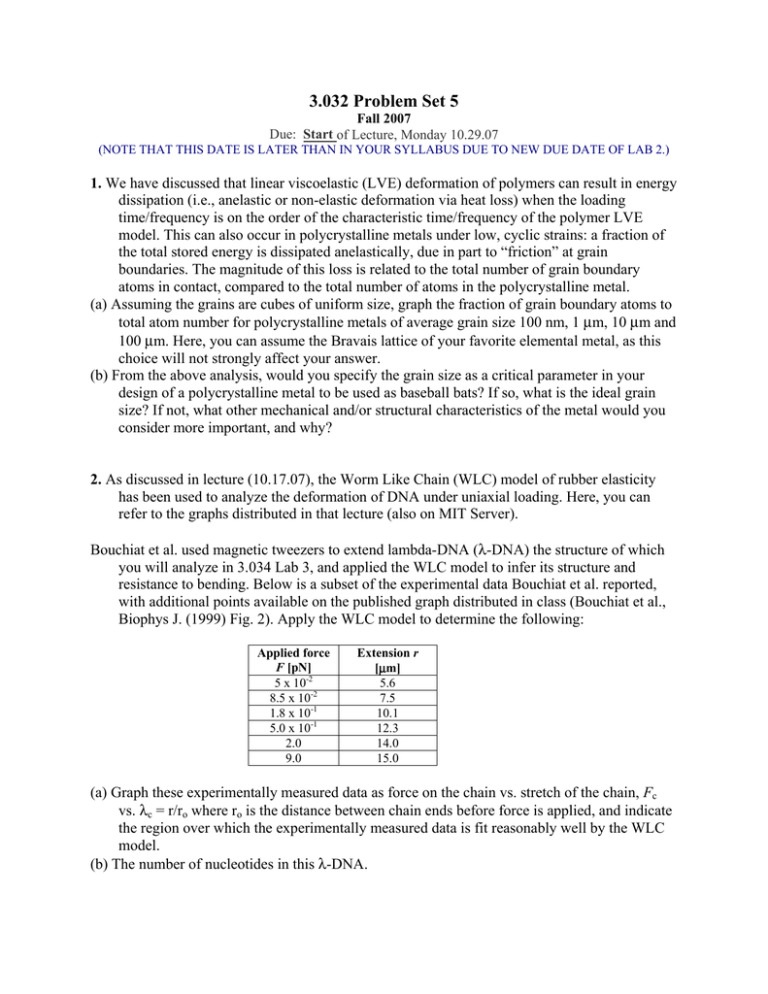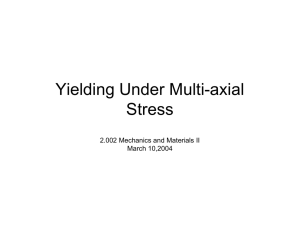3.032 Problem Set 5
advertisement

3.032 Problem Set 5 Fall 2007 Due: Start of Lecture, Monday 10.29.07 (NOTE THAT THIS DATE IS LATER THAN IN YOUR SYLLABUS DUE TO NEW DUE DATE OF LAB 2.) 1. We have discussed that linear viscoelastic (LVE) deformation of polymers can result in energy dissipation (i.e., anelastic or non-elastic deformation via heat loss) when the loading time/frequency is on the order of the characteristic time/frequency of the polymer LVE model. This can also occur in polycrystalline metals under low, cyclic strains: a fraction of the total stored energy is dissipated anelastically, due in part to “friction” at grain boundaries. The magnitude of this loss is related to the total number of grain boundary atoms in contact, compared to the total number of atoms in the polycrystalline metal. (a) Assuming the grains are cubes of uniform size, graph the fraction of grain boundary atoms to total atom number for polycrystalline metals of average grain size 100 nm, 1 μm, 10 μm and 100 μm. Here, you can assume the Bravais lattice of your favorite elemental metal, as this choice will not strongly affect your answer. (b) From the above analysis, would you specify the grain size as a critical parameter in your design of a polycrystalline metal to be used as baseball bats? If so, what is the ideal grain size? If not, what other mechanical and/or structural characteristics of the metal would you consider more important, and why? 2. As discussed in lecture (10.17.07), the Worm Like Chain (WLC) model of rubber elasticity has been used to analyze the deformation of DNA under uniaxial loading. Here, you can refer to the graphs distributed in that lecture (also on MIT Server). Bouchiat et al. used magnetic tweezers to extend lambda-DNA (λ-DNA) the structure of which you will analyze in 3.034 Lab 3, and applied the WLC model to infer its structure and resistance to bending. Below is a subset of the experimental data Bouchiat et al. reported, with additional points available on the published graph distributed in class (Bouchiat et al., Biophys J. (1999) Fig. 2). Apply the WLC model to determine the following: Applied force F [pN] 5 x 10-2 8.5 x 10-2 1.8 x 10-1 5.0 x 10-1 2.0 9.0 Extension r [μm] 5.6 7.5 10.1 12.3 14.0 15.0 (a) Graph these experimentally measured data as force on the chain vs. stretch of the chain, Fc vs. λc = r/ro where ro is the distance between chain ends before force is applied, and indicate the region over which the experimentally measured data is fit reasonably well by the WLC model. (b) The number of nucleotides in this λ-DNA. (c) The number of nucleotides that comprise a segment of the DNA that is significantly resistant to bending. (d) The effective entropic spring constant of λ-DNA, ks. Note that this is often defined as the resistance to extension at large forces – why is this? (Hint: See inset graph of Smith and Bustamante’s work on DNA.) Compare your value to that stated by the Bouchiat et al., and explain why they expressed this stiffness in units of [N] instead of [N/m]. (e) The minimal force required to break the phosphate ester bonds that join nucleotides in DNA? (f) The stretch λc = r/ro at which the WLC prediction diverges from that of the Freely Jointed Chain (FJC) model, by graphing the FJC prediction on the graph in (a), and the reasons for this divergence. 3. In Pset 3 (Question 1a), you were asked to analyze the stress state of an Al thin film that was to be used a metallization layer in an integrated circuit fabrication process. You are now interested in predicting whether the film under this biaxial stress state will yield according to three different yield criteria: maximum normal stress (also called Rankine criterion); Tresca criterion; and von Mises or J2-flow criterion. Here, explicitly consider that the throughthickness stress σzz = 0 as one of our three principal stresses. Assume the yield strength of the Al film in uniaxial tension and compression σy = 100 MPa. (a) Determine whether the Al film will yield using each of the three yield criteria mentioned above. (b) Graph the yield locus for each of the three different yield criterion on a graph of σ2/σy vs. σ1/ σy, where σ3=0. Which of the three criteria is the most conservative in predicting the stress state required for yielding? Which, if any, of the criteria is not suitable for the analysis of ductile materials such as aluminum? (c) Now assume that instead of a biaxial stress state, the Al film is under pure shear loading (only τ12 is nonzero). Considering the Tresca and von Mises criteria separately, what percentage of the material’s yield strength does an applied stress σa have to achieve in order to produce yielding under pure shear conditions? 4. The stress states at which amorphous, glassy polymers such as polystyrene and polycarbonate yield are sensitive to pressure p = σii/3, where σii = I1, the first invariant of the stress tensor σij. Such polymers can yield either by shear band formation or by crazing. As a result, the biaxial stress states at which these polymers yield in compression is quite different from that in which they fail in tension, and the yield locus is not centered at (0, 0). (a) Based on your knowledge of how macromolecules would deform under compression vs. tension during shear band formation or crazing, predict whether you would expect yielding to occur at lower principal stresses in tension vs. in compression. (b) Based on this prediction, draw the von Mises yield locus for a material which shows pressure-insensitive yielding, and superpose on that graph the yield locus for polystyrene. Note that Mohr (of Mohr’s circle fame) was the first to note this tension/compression asymmetry, and this criterion is often called the Mohr-Coulomb failure criterion. 5. So many people were working on the prediction of metal yielding around WWI that the von Mises yield criterion has many names, including the J2-flow criterion, maximum shear deformation energy criterion, and maximum distortional energy criterion. Here you will show that you can calculate the von Mises yield criterion even if you do not know that J2 is the second invariant of the deviatoric stress tensor sij. (a) The strain energy density U of an elastically deformed material is the area under the uniaxial stress-strain response in the elastic region. Write an expression for U(σ, ε) for linear elastic, uniaxial deformation, as is typical of a metal. (b) Linear deformations are superposable, so now write U(σi, εi) assuming an applied triaxial, principal stress state. (c) Each of these strains εi can be expressed as εi (σi, E, ν), so now express U in terms of only σi, E, and ν. (d) This strain energy density is the sum of the energy to cause volume change and the energy to cause shape change (distortion), or U = Uv + Ud. Because the average stress (σavg = (σii/3 = σhydrostatic causes equal principal strains in all 3 directions, the volume change is due to σii/3, and the shape or distortional change is the rest of the stress, or (σ1 – σii/3), (σ2 – σii/3), and (σ3 – σii/3). Now express the distortional strain energy density Ud (σi, E, ν) by replacing the total stress components in (c) with these distortional stress components. (e) von Mises criterion says that the material failure occurs when this distortional energy for some arbitrary σij reaches the value that would be attained at yielding under uniaxial loading, or when Ud = (Ud)y. Consider the case of plane stress (σ3 = 0), and equate Ud with that attained for yielding in uniaxial tension (Ud)y to derive an expression for σy(σ1, σ2). As a check, this should be the equation of the ellipse that defines the von Mises yield locus!





